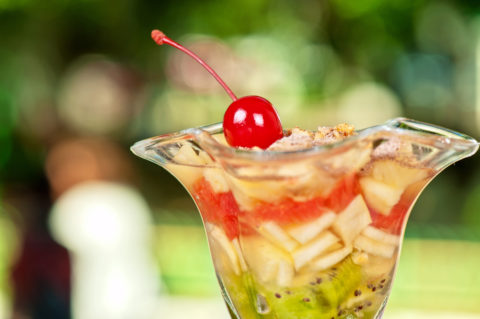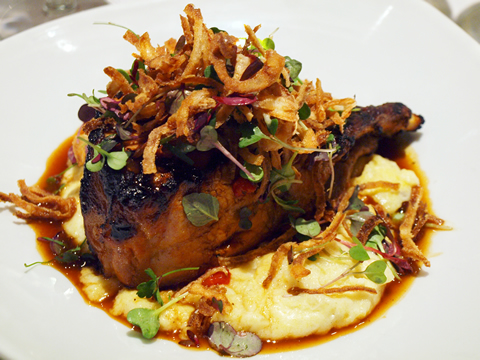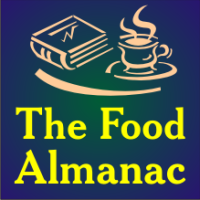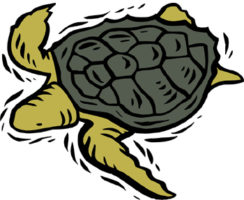 Monday, June 12, 2017.
Serious Red Beans And Rice.
Monday, June 12, 2017.
Serious Red Beans And Rice.
MA is busy getting the radio show pulled together for the days she will be hosting it, as well as to line up guests for the fill-in hosts. I'm sure glad she takes care of these matters.
I go to Abita Roaster for lunch. They get my current first-place award for red beans and rice these days. The beans are of perfect texture and seasoning. The hot sausage comes in an extra-wide pattie, just peppery enough, carrying the rich amount of rendered red fat. The deal also comes with a corn pancake. Like a regular pancake, but with the texture of cornbread as opposed to biscuits.
I stay home for the radio show, because that's what I do on Mondays, with or without a chorus rehearsal.
Tuesday, June 13, 2017. Caribbean Room News. Down The Bayou.
I don't know whether this is an encouraging sign, but during the past twenty-four hours, three people told me that they went to the Caribbean Room in the refurbished Pontchartrain Hotel, and found it excellent. That is not what I had been hearing and experiencing myself a few months ago. Maybe it's time for me to revisit the revived classic. Perhaps even more encouraging is that all three of the people who say they liked the food at the C-Room mentioned the fact that jackets are required for gentlemen diners there. They seemed to find that enjoyable. Now we're getting somewhere! I think about going there tonight myself. But it's Tuesday, and I don't think they have live music that night. I think about other possibilities for dinner. The Upperline? Closed on Tuesdays. A few other places with comparable problems. Then calls Mary Ann, who thinks that DTB--a new restaurant on the Oak Street strip in the Riverbend--is a place we ought to visit. If I were without the Marys to push me along, I would have rejected the place as too new. But they love brand-new eateries, and suddenly there we are, after I hold down the table for a half-hour while ML changes clothes. One other aspect of DTB ("down the bayou") that softens my thoughts is its proximity to a neighborhood where I lived and worked for three or four years in my young twenties. It's a block and a half from Time Saver #1, where I worked for nine years during high school and college, before leaving for the newspaper business, for which I began writing restaurant reviews in 1972. Most memorable Time Saver #1 moment: being held up by a man with a gun. He beat up my co-worker pretty badly. I stepped up just as the robber and his accomplice made for the exit. He didn't touch me. I got a good look at the gun. I think it was a toy. The arrival of the Marys knocks that reverie out of my mind. I greet them with a batch of hand-cut fries, our standard appetizer when the three of us are dining out. The menu and the kitchen are ready for orders like that, and we keep on ordering. Fried cornbread (like hush puppies). Roasted asparagus with green beans, all cut into unidentifiable pieces, but remain good anyway. A new approach to Drago's-style char-broiled oysters has the same ingredients baked in a gratin dish. A duck confit that MA orders. She has a new hunger for duck these days. Fried catfish in classic style, very generous and just right. I'm glad to have found out about this place, which seems to have its act very much together. MA loves the environment, which is decked with industrial-strength flooring, window coverings, and ceilings. It's not loud, even though it was full during most of our time there. Halfway through, the man who served my sister Lynn and I a couple of weeks ago at Cavan walks up to the table. I recognize him immediately: he has an accent from his homeland Lithuania. I also remember his name easily: Tomas. He says that he liked what I said about him in a Dining Diary piece last week. He doesn't work here at DTB, but is just having dinner. As he leaves, I tell him good-bye in Russian. I took that language for two years at UNO, and don't remember much of it. Luckily, Vladimir Putin doesn't come up in the conversation. I later learn that DTB (whose sub-name is Social House,) was assembled by a group of chefs, cocktail experts, sommeliers and dessert specialists. Most of them learned their strokes at Commander's Palace or other restaurants allied with it. That's not a bad point from which to branch out.DTB Social House. Riverbend: 8201 Oak St. 504-518-6889.
[divider type=""]
Brandied Fruit Thaïs
When Brennan's invented bananas Foster and got everybody talking about it, other restaurants reacted in two ways. First, they came up with new flaming fruit desserts with ice cream. Later, they just began serving bananas Foster. If a restaurant did both things, the dessert in step one often disappeared. That happened to this great creation of the Pontchartrain Hotel's Caribbean Room. It's a collection of juicy fruits (and bananas), sprinkled with brown sugar and flamed with brandy. The added touch of topping it with crumbled macaroon cookies and almonds made it both unique and spectacular. I think the problem with it was that it was too big to serve at just one table, and it wound up in the C-Room's banquet repertoire. [caption id="attachment_55153" align="alignnone" width="480"] Brandied fruit salad Thais.[/caption]The dish is named for the Massenet opera of the same name, or perhaps for the original book by Anatole France. Classy restaurants often made literary references in those days.
Brandied fruit salad Thais.[/caption]The dish is named for the Massenet opera of the same name, or perhaps for the original book by Anatole France. Classy restaurants often made literary references in those days.
- 2 peaches or nectarines, or 8 apricots
- 2 ripe pears
- 1/2 of a whole fresh pineapple, cored
- 1 slightly underripe banana
- 1 cup pitted and halved fresh Bing or Raniere cherries (about 15 of them)
- 1/2 cup amontillado or fino sherry
- 1 cup brown sugar
- 4 oz. slivered almonds
- 1 stick cold unsalted butter
- 2 cups of crumbled coconut macaroon cookies or almond cookies
- 1 1/2 oz. brandy
- 1 quart vanilla ice cream
1. Peel the peaches or nectarines or apricots and the pineapple, and cut it into dice the size that come with your Monopoly set. Slice the bananas about a quarter-inch thick.
2. Put all the fruits into a two-quart non-metallic baking dish. Pour the sherry over the fruits. Cover and marinate for two to four hours. Don't refrigerate.
3. About a half-hour before you're ready to serve, preheat the oven to 350 degrees. Add the brown sugar, almonds, and half of the crushed cookies to the fruit. Cut the butter into chips and add. With a big spoon, lightly toss the contents of the dish.
4. Top the fruit mixture with the remaining cookie crumbs. Put the baking dish into the 350-degree oven, uncovered, and bake for 12-15 minutes, until the top is browned.
5. At the table, pour the brandy over the hot fruit and touch a flame to it. (Be careful that nothing overhead is inflammable. Don't flame if you don't feel safe about it.) Spoon the fruit over scoops of ice cream and serve.
Serves 12-16.
[divider type=""]
 Double-Cut Pork Chop @ Rue 127
Double-Cut Pork Chop @ Rue 127
My favorite entree at this compact but excellent Mid-City bistro is a thick slab of bone-in pork loin. The menu makes no claim for its source--it's not from a Mangalitsa or Kurabuta pig. It's lean and beautifully trimmed. Yet it lacks nothing in its flavor. Could win against the pedigreed chops in a blind tasting. I suspect it may be brined (a good thing). The sauce is made with whiskey and roasted peppers, with corn coush-coush (pudding) on the side. Finally, they have the good sense to leave it a little pink in the middle (which the USDA has declared is perfectly safe).

Rue 127. Mid-City: 127 N Carrollton Ave. 504-483-1571.
This is among the 500 best dishes in New Orleans area restaurants. Click here for a list of the other 499. [divider type=""] June 16, 2017
June 16, 2017
Days Until. . . Father's Day 3
Food Calendar
This is International Chorizo Day. Chorizo is a dense pork sausage made in Spain and Portugal, as well is most of the former colonies of those two countries. The pork is chopped and packed with a visible amount of fat, along with seasonings. Smoked paprika is one of the major spices, which give the sausage a little piquancy and a red color. Most Spanish chorizo is cured and smoked, and can be eaten as is. In this part of the world, however, there's another kind: chorizo fresca. This must be cooked before being eaten. Chefs are finding more uses for both kinds of chorizo in their cookery. It's good almost any way its used: with eggs, as a seasoning meat, in a salad, with mussels, or as tapas. A restaurant that takes chorizo seriously may have several varieties of the sausage. Today is also allegedly National Fudge Day. Oh, fudge. We had a wonderful dog once named Fudge. My mother made a super-sweet fudge which was one of the few things she cooked that I never liked. That's all I've got.
Gourmet Gazetteer
Egg Bend, Louisiana is on a large loop in the Red River, twenty-four miles southeast of Alexandria, in Avoyelles Parish. The community is right on the river's levee. It's a small farming village on the old, winding LA Highway 1, before that highway was straightened many years ago. The nearest place to eat is B's Diner, up LA 1 two miles. But the real action is in Marksville, seven miles downstream.
Edible Dictionary
plate, n.--A cut of beef adjacent to the lower end of the ribs. It's between the brisket and the flank. The word "plate" is used much more by butchers than by consumers. You will not often see the expression on the label of a package of beef. It has a lot of fat on both sides and a good deal of connective tissue too. It's a job to trim it down to remove all the chewy parts. What comes out of that effort is good indeed. Pastrami made in the traditional way uses meat from the front part of the plate. The skirt steak, which has become very popular because of the demand for fajitas, has really put the plate to work. The whole thing can be braised to good effect for stews.
Annals Of Junk Food
Today in 1903, the Patent Office granted a trademark for Pepsi-Cola. It's named for pepsin (an enzyme that was supposed to help digestion) and the kola nut, which supplied not only a distinctive flavor but also caffeine. The formula also included vanillin and fruit extracts. Pharmacist Caleb D. Bradham was its creator; like most druggists, he had a soda fountain in his establishment. Today is the birthday (1893!) of Cracker Jack. The achievement of its creator R.W. Rueckheim was to coat popcorn and peanuts with caramel in such a way that they wouldn't stick together. The name was slang of the time for something that would be called "awesome" today. Sailor Jack and his dog Bingo were on the box from the beginning.
Food In Literature
This is Bloomsday, so called by avid fans of James Joyce's landmark novel Ulysses. The peripatetic wanderings of Leopold Bloom and the other characters in the book begin on this day and end the next. Much food and wine is consumed along the way. I once made the mistake of trying to listen to an audiobook of Ulysses, and found it impossible. Fortunately, I have the actual book, which I should have read in college. Someday I will finally get around to reading it, and turning in my report to the professor in hopes of having that D reversed.
Food And The Environment
 Archie Fairley Carr, a marine biologist, was born today in 1909. He spent much of his career studying sea turtles, and as a result discovered why their numbers were decreasing so rapidly. His work had two results: we no longer use green sea turtles for turtle soup (as we did as recently as the 1980s), and the turtle populations are beginning to rebound, leaving them free to get covered with BP oil.
Archie Fairley Carr, a marine biologist, was born today in 1909. He spent much of his career studying sea turtles, and as a result discovered why their numbers were decreasing so rapidly. His work had two results: we no longer use green sea turtles for turtle soup (as we did as recently as the 1980s), and the turtle populations are beginning to rebound, leaving them free to get covered with BP oil.
Food In The Movies
The movie Grease premiered today in 1978, with John Travolta and Olivia Newton-John. Not the kind of grease we encounter in culinary work. But it gives me an opening to bring up a usage matter. "Grease" is an ugly word to use when talking about food. My skin crawls when I hear a cook saying something like, "Then you put the soft shell crabs into the hot grease. . ." To me, the only acceptable uses of the word are in a pejorative context, as in "The pot of chili had a half-inch-deep layer of orange grease floating on top." Let's eliminate "grease" from the language of fine cooking.
Deft Dining Rule #183
Restaurants that use the word "grease" in their descriptions of their food are very likely to serve greasy food.
Food Namesakes
Jim Dine, a major force in Pop Art, made his first strokes today in 1938. . . August Busch III, the boss of Anheuser-Busch, the country's biggest brewer of beer, showed his head today in 1940. . . Novelist Joyce Carol Oates made her first statement today in 1941. I've read many of her short stories, but never her big works, like The Time Traveler. Any good?. . . The Dan Quayle Vice-Presidential Center and Musuem opened today in 1993, in Huntington, Indiana.
Words To Eat By
"Always serve too much hot fudge sauce on hot fudge sundaes. It makes people overjoyed, and puts them in your debt."--Judith Olney, food writer. "I know my corn plants intimately, and I find it a great pleasure to know them."--Barbara McClintock, American botanist, born today in 1902.
Words To Drink By
"I'm going to be around until the Atomic Energy Commission finds a safe place to bury my liver."--Phil Harris, comedian and musician, and early king of Bacchus. The AEC must have found the spot in 1995.
[divider type=""]

The Difference Between Pork And Beef.
The beef, one might imagine, is more refined between the grazing grass and the poor boy sandwich.Click here for the cartoon.
[divider type=""]